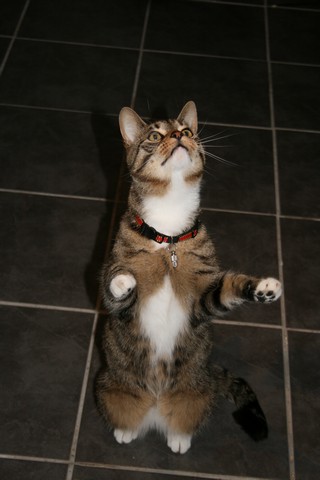Rear
Cats can rear into a position where they end up standing on their hind legs either supporting their own weight or supporting their weight against an object. In both positions the head is usually extended on the neck and may be mobile as the cat passively explores the environment. The tail is usually hanging downwards towards the ground. Self supported rearDuring a self supported rear, the cat lifts its forequarters vertically into the air whilst shifting its weight backwards such that the centre of gravity moves to over its hind limbs. The hind limbs are usually flexed to support the body weight and balance the cat. Usually the front legs are folded so that the paws are flexed at the carpi (wrists) such that the paws hang downwards parallel with the body. The position is usually only maintained for short periods.
Object supported rearThis position can be supported for longer periods as the cat lifts its forequarters off the ground but then places its front paws against a vertical surface or onto a higher horizontal surface so that the full weight is not balanced over the hind legs. For this reason in an object supported rear the body may be angled forwards as the centre of gravity does not need to shift backwards as much and the hind limbs may be flexed but are more commonly extended (to give the cat additional height). |
|||||||

Compiled by:
Dr Sarah Ellis, Helen Zulch and Jenna Kiddie

